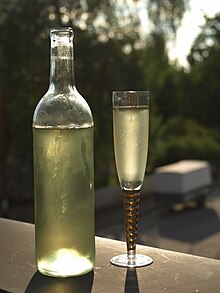 Swedish elderflower-flavored mead. | |
| Type | fermented beverage |
|---|---|
| Alcohol by volume | 3.5–20.5% |
| Proof (US) | 7°–41° |
| Color | pale yellow |
| Flavor | dry, sweet or semi-sweet |
| Ingredients | honey, water, fruit, herbs, spices |
| Variants | metheglyn, chouchen, bochet |
| Related products | tej, midus, medovukha, bais, balché |
Mead (/miːd/), also called honey wine, and hydromel (particularly when low in alcohol content), is an alcoholic beverage made by fermenting honey mixed with water, and sometimes with added ingredients such as fruits, spices, grains, or hops.[1][2][3] The alcoholic content ranges from about 3.5% ABV[4] to more than 20%. Possibly the most ancient alcoholic drink, the defining characteristic of mead is that the majority of the beverage's fermentable sugar is derived from honey.[5] It may be still, carbonated, or naturally sparkling, and despite a common misconception that mead is exclusively sweet, it can also be dry or semi-sweet.[6][7][8]
Mead that also contains spices is called metheglin (/mɪˈθɛɡlɪn/), and mead that contains fruit is called melomel. The term honey wine is sometimes used as a synonym for mead,[9][10] although wine is typically defined to be the product of fermented grapes or certain other fruits,[11] and some cultures have honey wines that are distinct from mead. The honey wine of Hungary, for example, is the fermentation of honey-sweetened pomace of grapes or other fruits.[12]
Mead was produced in ancient times throughout Europe, Africa, and Asia,[13][14][15][16] and has played an important role in the mythology of some peoples. In Norse mythology, for example, the Mead of Poetry, crafted from the blood of Kvasir, would turn anyone who drank it into a poet or scholar.
- ^ "Mead dictionary definition | mead defined". www.yourdictionary.com.
- ^ Beer is produced by the fermentation of grain, but the grain can be used in mead provided it is strained off immediately. As long as the primary substance fermented is still honey, the drink is still mead.Fitch, Ed (1990). The Rites of Odin (1st ed.). Llewellyn Worldwide. p. 290. ISBN 978-0-87542-224-4.
- ^ Hops are better known as the bitter ingredient of beer. However, they have also been used in mead both ancient and in modern times. The Legend of Frithiof mentions hops: Mohnike, G.C.F. (September 1828 – January 1829). "Tegner's Legend of Frithiof". The Foreign Quarterly Review. III. London: Treuttel and Würtz, Treuttel, Jun and Richter.
He next ... bids ... Halfdan recollect ... that to produce mead hops must be mingled with the honey;
That this formula is still in use is shown by the recipe for "Real Monastery Mead" in Molokhovets, Elena (1998). Classic Russian Cooking: Elena Molokhovets' A Gift to Young Housewives. Translated by Joyce Stetson. Indiana University Press. p. 474. ISBN 978-0-253-21210-8. - ^ Lichine, Alexis (1987). Alexis Lichine's new encyclopedia of wines & spirits. Knopf. OCLC 1244230688.
- ^ Gayre, Robert (1986). Brewing Mead. Brewers Publications. p. 158. ISBN 978-0-937381-00-7.
...Therefore to our synopsis: Mead is the general name for all drinks made of honey.
- ^ Rose, Anthony H. (1977). Alcoholic Beverages. Michigan: Academic Press. p. 413.
- ^ Fitzsimons, Tim (1 May 2011). "Medieval No More: Mead Enjoys A Renaissance". NPR. Retrieved 24 June 2024.
- ^ "Mead leaves the dark ages behind". The Sydney Morning Herald. 3 January 2011. Retrieved 24 June 2024.
- ^ Morse, Roger (1992). Making Mead (Honey Wine). Wicwas Press. ISBN 978-1-878075-04-8.
- ^ Schramm, Ken (2003). The Compleat Meadmaker: Home Production of Honey Wine From Your First Batch to Award-winning Fruit and Herb Variations. Brewers Publications. ISBN 978-0-937381-80-9.
- ^ Robinson, Jancis (1999). The Oxford Companion to Wine (2nd ed.). Oxford University Press. p. 775.
- ^ "History of beer in Hungary". Archived from the original on 28 September 2010.
- ^ Toussaint-Samat, Maguelonne (2009). A history of food. Wiley-Blackwell. ISBN 978-1-4051-8119-8. OCLC 1020512534.
- ^ Hornsey, Ian (2003). A History of Beer and Brewing. Royal Society of Chemistry. p. 7. ISBN 978-0-85404-630-0.
...mead was known in Europe long before wine, although archaeological evidence of it is rather ambiguous. This is principally because the confirmed presence of beeswax or certain types of pollen ... is only indicative of the presence of honey (which could have been used for sweetening some other drink) – not necessarily of the production of mead.
- ^ "The Funerary Feast of King Midas @ the Penn Museum | Remains of a Feast".
- ^ Lévi-Strauss, Claude (1983). From honey to ashes. University of Chicago Press. ISBN 0-226-47489-5. OCLC 664396551.